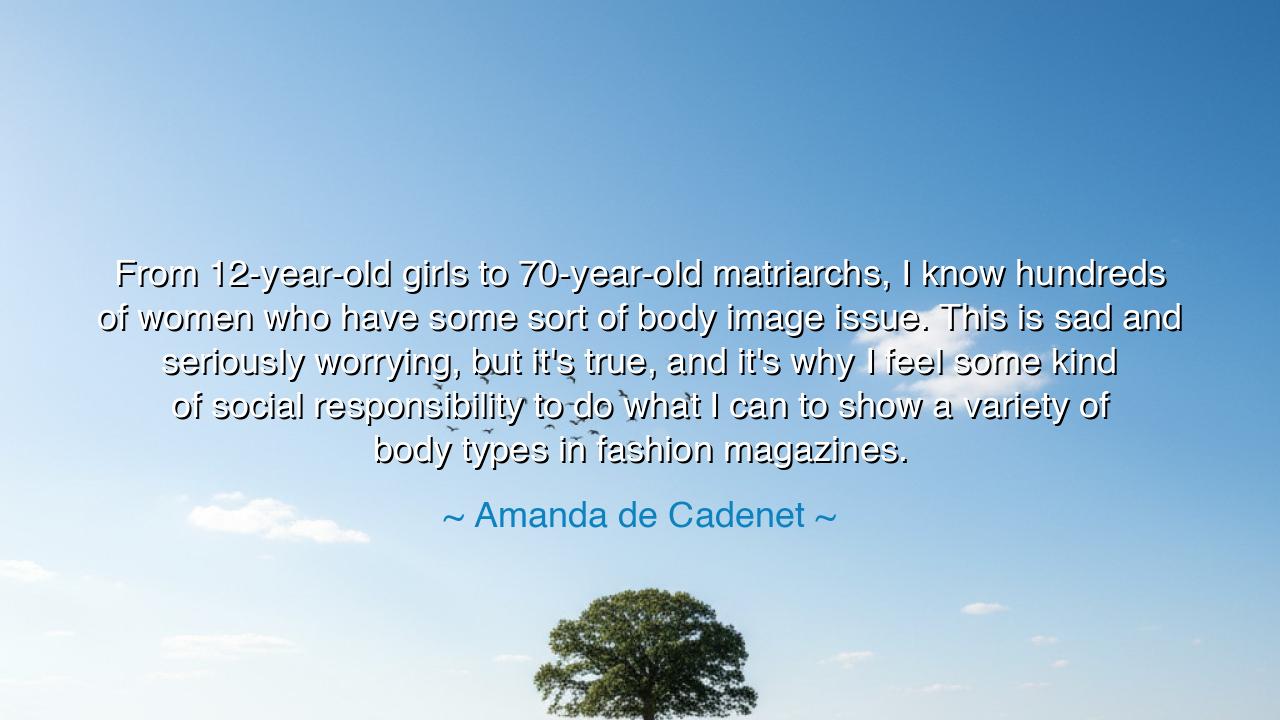
From 12-year-old girls to 70-year-old matriarchs, I know hundreds
From 12-year-old girls to 70-year-old matriarchs, I know hundreds of women who have some sort of body image issue. This is sad and seriously worrying, but it's true, and it's why I feel some kind of social responsibility to do what I can to show a variety of body types in fashion magazines.






The words of Amanda de Cadenet fall with a tone both mournful and resolute: “From 12-year-old girls to 70-year-old matriarchs, I know hundreds of women who have some sort of body image issue. This is sad and seriously worrying, but it's true, and it's why I feel some kind of social responsibility to do what I can to show a variety of body types in fashion magazines.” In these lines she names a universal wound, one carried silently by women across ages and generations. It is the wound of comparison, of judgment, of looking in the mirror and finding only lack. Yet her words do not stop at lament; they rise into a vow of responsibility—to use her influence in the world of fashion to heal, or at least to resist, this suffering.
The origin of her reflection lies in her long experience as a photographer, journalist, and advocate within the world of media. De Cadenet saw firsthand how the relentless portrayal of a single, narrow ideal of beauty—youthful, thin, and airbrushed—shaped the minds of women and girls. To encounter so many, from the tender age of twelve to the wisdom of seventy, all carrying the same sense of inadequacy, was to see a tragedy repeated through generations. Her sorrow is real, but from it she draws resolve: to broaden representation, to make visible the beauty that already exists in every body.
This struggle is not new. History itself bears witness to shifting ideals of beauty that have oppressed or liberated women in turn. In the Renaissance, fuller bodies were celebrated as signs of fertility and wealth, painted into immortality by masters like Rubens. Yet in other eras, such as the corseted age of the Victorians, women endured pain and restriction to achieve a socially demanded silhouette. The lesson of history is clear: beauty standards are not divine laws but cultural constructs, and when enforced cruelly, they enslave generations. De Cadenet’s recognition of this pattern places her among those who dare to challenge it in her own time.
Her words also reveal the power of media as both a weapon and a tool of healing. Fashion magazines, with their glossy images and glamorous spreads, have long dictated the boundaries of “acceptable beauty.” For many women, to flip through their pages is to encounter an endless chorus of voices whispering, you are not enough. De Cadenet turns this weapon on its head: if magazines shape perception, then let them shape it toward truth and inclusivity. In this way, she acknowledges her own power as both a participant in and reformer of the system.
Yet the most moving part of her reflection is her acknowledgment of social responsibility. Too often, those with influence hide behind neutrality, claiming they merely reflect society’s desires. But she sees that to remain silent is to perpetuate harm. Just as leaders of old were called to protect the vulnerable, so too does she take up the call to protect women and girls from the corrosive lie that they are unworthy unless they conform. In this sense, her work is not just art—it is an act of guardianship.
The lesson is clear: beauty is not singular, but manifold, and to deny its variety is to deny the dignity of countless lives. We must challenge the voices, both within and without, that diminish us. We must learn to honor the body as it is—strong, scarred, changing, unique. And those who hold power over images, words, and symbols must wield that power responsibly, for every portrayal either builds or destroys the self-worth of those who behold it.
Practically, this means seeking out and supporting representations that affirm diversity of form. It means speaking openly about body image struggles, so the silence is broken and shame loses its grip. It means teaching children—especially daughters—that their worth lies not in conformity to an image, but in the richness of their humanity. And for those in positions of influence, it means doing as de Cadenet does: actively working to broaden the images presented to society.
Thus, Amanda de Cadenet’s words are not only a lament but a command to future generations: see the wound, and do not turn away. If beauty has been used as a chain, let us transform it into a crown. If images have enslaved, let them now liberate. And let us all take up the same responsibility—to honor the infinite variety of human beauty, so that no girl or woman, young or old, will ever again look in the mirror and see only sadness.






AAdministratorAdministrator
Welcome, honored guests. Please leave a comment, we will respond soon